Thiol-Ene Click-Inspired Late-Stage Modification of Long-Chain Polyurethane Dendrimers
Abstract
:1. Introduction
2. Results and Discussion
3. Conclusions
4. Experimental Section
Supplementary Materials
Author Contributions
Funding
Institutional Review Board Statement
Informed Consent Statement
Data Availability Statement
Acknowledgments
Conflicts of Interest
References
- Sowinska, M.; Urbanczyk-Lipkowska, Z. Advances in the Chemistry of Dendrimers. New J. Chem. 2014, 38, 2168–2203. [Google Scholar] [CrossRef]
- Fréchet, J.M.J. Functional Polymers and Dendrimers: Reactivity, Molecular Architecture, and Interfacial Energy. Science 1994, 263, 1710–1715. [Google Scholar] [CrossRef]
- Sandra García-Gallego, M.M. Dendrimer Chemistry: Synthetic Approaches Towards Complex Architectures; Croydon Royal Society of Chemistry: London, UK, 2020. [Google Scholar]
- Tomalia, D.A.; Fréchet, J.M.J. Discovery of Dendrimers and Dendritic Polymers: A Brief Historical Perspective. J. Polym. Sci. Part A Polym. Chem. 2002, 40, 2719–2728. [Google Scholar] [CrossRef]
- Sebestik, J.; Reinis, M.; Jezek, J. Biomedical Applications of Peptide-, Glyco-, and Glycopeptide Dendrimers, and Analogous Dendrimeric Structurrs; Springer: Berlin/Heidelberg, Germany, 2012. [Google Scholar]
- Astruc, D.; Boisselier, E.; Ornelas, C. Dendrimers Designed for Functions: From Physical, Photophysical, and Supramolecular Properties to Applications in Sensing, Catalysis, Molecular Electronics, Photonics, and Nanomedicine. Chem. Rev. 2010, 110, 1857–1959. [Google Scholar] [CrossRef]
- Sharma, A.; Liaw, K.; Sharma, R.; Spriggs, T.; Appiani La Rosa, S.; Kannan, S.; Kannan, R.M. Dendrimer-Mediated Targeted Delivery of Rapamycin to Tumor-Associated Macrophages Improves Systemic Treatment of Glioblastoma. Biomacromolecules 2020, 21, 5148–5161. [Google Scholar] [CrossRef]
- Takeda, S.; Nishimura, T.; Umezaki, K.; Kubo, A.; Yanase, M.; Sawada, S.I.; Sasaki, Y.; Akiyoshi, K. Synthesis and Function of Amphiphilic Glucan Dendrimers as Nanocarriers for Protein Delivery. Biomater. Sci. 2019, 7, 1617–1622. [Google Scholar] [CrossRef]
- Wang, X.Q.; Wang, W.; Li, W.J.; Chen, L.J.; Yao, R.; Yin, G.Q.; Wang, Y.X.; Zhang, Y.; Huang, J.; Tan, H.; et al. Dual Stimuli-Responsive Rotaxane-Branched Dendrimers with Reversible Dimension Modulation. Nat. Commun. 2018, 9, 3190. [Google Scholar] [CrossRef]
- Wang, Y.; Zhu, X. Nanofabrication within Unimolecular Nanoreactors. Nanoscale 2020, 12, 12698–12711. [Google Scholar] [CrossRef]
- Watabe, T.; Ishizuki, K.; Aoki, D.; Otsuka, H. Mechanochromic Dendrimers: The Relationship between Primary Structure and Mechanochromic Properties in the Bulk. Chem. Commun. 2019, 55, 6831–6834. [Google Scholar] [CrossRef]
- Xu, X.; Zhang, P.; Wu, B.; Xing, Y.; Shi, K.; Fang, W.; Yu, H.; Wang, G. Photochromic Dendrimers for Photoswitched Solid-To-Liquid Transitions and Solar Thermal Fuels. ACS Appl. Mater. Interfaces 2020, 12, 50135–50142. [Google Scholar] [CrossRef]
- Astruc, D.; Chardac, F. Dendritic Catalysts and Dendrimers in Catalysis. Chem. Rev. 2001, 101, 2991–3023. [Google Scholar] [CrossRef]
- Ghobril, C.; Rodriguez, E.K.; Nazarian, A.; Grinstaff, M.W. Recent Advances in Dendritic Macromonomers for Hydrogel Formation and Their Medical Applications. Biomacromolecules 2016, 17, 1235–1252. [Google Scholar] [CrossRef]
- Loch, A.S.; Stoltzfus, D.M.; Burn, P.L.; Shaw, P.E. High-Sensitivity Poly(Dendrimer)-Based Sensors for the Detection of Explosives and Taggant Vapors. Macromolecules 2020, 53, 1652–1664. [Google Scholar] [CrossRef]
- Lyu, Z.; Ding, L.; Tintaru, A.; Peng, L. Self-Assembling Supramolecular Dendrimers for Biomedical Applications: Lessons Learned from Poly(Amidoamine) Dendrimers. Acc. Chem. Res. 2020, 53, 2936–2949. [Google Scholar] [CrossRef]
- Majoral, J.P.; Mignani, S.M.; Shi, X.; Rodrigues, J.M.; Muñoz-Fernández, M.Á.; Ceña, V.; Roy, R. Dendrimers towards Translational Nanotherapeutics: Concise Key Step Analysis. Bioconjug. Chem. 2020, 31, 2060–2071. [Google Scholar]
- Jiang, W.; Stolterfoht, M.; Jin, H.; Paul, L.B. Hole-Transporting Poly(dendrimer)s as Electron Donors for Low Donor Organic Solar Cells with Efficient Charge Transport. Macromolecules 2020, 53, 2902–2911. [Google Scholar] [CrossRef]
- Mignani, S.; Shi, X.; Steinmetz, A.; Majoral, J.P. Multivalent Copper(II)-Conjugated Phosphorus Dendrimers with Noteworthy in Vitro and in Vivo Antitumor Activities: A Concise Overview. Mol. Pharm. 2021, 18, 65–73. [Google Scholar] [CrossRef]
- Puttock, E.V.; Ranasinghe, C.S.K.; Babazadeh, M.; Jang, J.; Huang, D.M.; Tsuchiya, Y.; Adachi, C.; Burn, P.L.; Shaw, P.E. Solution-Processed Dendrimer-Based TADF Materials for Deep-Red OLEDs. Macromolecules 2020, 53, 10375–10385. [Google Scholar] [CrossRef]
- Tomalia, D.A.; Baker, H.; Hall, M.; Kallos, G.; Martin, S.; Ryder, J.; Smith, P. Dendritic Macromolecules:1 Synthesis of Starburst Dendrimers. Macromolecules 1986, 19, 2466–2468. [Google Scholar] [CrossRef]
- Agrahari, A.K.; Singh, A.S.; Mukherjee, R.; Tiwari, V.K. An Expeditious Click Approach towards the Synthesis of Galactose Coated Novel Glyco-Dendrimers and Dentromers Utilizing a Double Stage Convergent Method. RSC Adv. 2020, 10, 31553–31562. [Google Scholar] [CrossRef]
- Thomas, B.; Pifferi, C.; Daskhan, G.C.; Fiore, M.; Berthet, N.; Renaudet, O. Divergent and Convergent Synthesis of GalNAc-Conjugated Dendrimers Using Dual Orthogonal Ligations. Org. Biomol. Chem. 2015, 13, 11529–11538. [Google Scholar] [CrossRef]
- Zhang, Y.; Üçüncü, M.; Gambardella, A.; Baibek, A.; Geng, J.; Zhang, S.; Clavadetscher, J.; Litzen, I.; Bradley, M.; Lilienkampf, A. Bioorthogonal Swarming: In Situ Generation of Dendrimers. J. Am. Chem. Soc. 2020, 142, 21615–21621. [Google Scholar] [CrossRef]
- Zhou, H.Y.; Zong, Q.S.; Han, Y.; Chen, C.F. Recent Advances in Higher Order Rotaxane Architectures. Chem. Commun. 2020, 56, 9916–9936. [Google Scholar] [CrossRef]
- El Hankari, S.; Katir, N.; Collière, V.; Coppel, Y.; Bousmina, M.; Majoral, J.P.; El Kadib, A. Urea-Assisted Cooperative Assembly of Phosphorus Dendrimer-Zinc Oxide Hybrid Nanostructures. New J. Chem. 2019, 43, 2141–2147. [Google Scholar] [CrossRef]
- Farabi, K.; Manabe, Y.; Ichikawa, H.; Miyake, S.; Tsutsui, M.; Kabayama, K.; Yamaji, T.; Tanaka, K.; Hung, S.C.; Fukase, K. Concise and Reliable Syntheses of Glycodendrimers via Self-Activating Click Chemistry: A Robust Strategy for Mimicking Multivalent Glycan-Pathogen Interactions. J. Org. Chem. 2020, 85, 16014–16023. [Google Scholar] [CrossRef]
- Kaufman, E.A.; Tarallo, R.; Elacqua, E.; Carberry, T.P.; Weck, M. Synthesis of Well-Defined Bifunctional Newkome-Type Dendrimers. Macromolecules 2017, 50, 4897–4905. [Google Scholar] [CrossRef]
- Li, W.J.; Hu, Z.; Xu, L.; Wang, X.Q.; Wang, W.; Yin, G.Q.; Zhang, D.Y.; Sun, Z.; Li, X.; Sun, H.; et al. Rotaxane-Branched Dendrimers with Enhanced Photosensitization. J. Am. Chem. Soc. 2020, 142, 16748–16756. [Google Scholar] [CrossRef]
- Milenin, S.A.; Cherkaev, G.V.; Demchenko, N.V.; Serkova, E.S.; Krasnova, I.Y.; Selezneva, E.V.; Buzin, M.I.; Bakirov, A.V.; Vasil’ev, V.G.; Shifrina, Z.B.; et al. Influence of the Growing Flexible Shell on the Molecular Behavior of Hybrid Dendrimers. Macromolecules 2020, 53, 9706–9716. [Google Scholar] [CrossRef]
- Molina, N.; Nájera, F.; Guadix, J.A.; Perez-Pomares, J.M.; Vida, Y.; Perez-Inestrosa, E. Synthesis of Amino Terminal Clicked Dendrimers. Approaches to the Application as a Biomarker. J. Org. Chem. 2019, 84, 10197–10208. [Google Scholar] [CrossRef]
- Sharma, R.; Kottari, N.; Chabre, Y.M.; Abbassi, L.; Shiao, T.C.; Roy, R. A Highly Versatile Convergent/Divergent “Onion Peel” Synthetic Strategy toward Potent Multivalent Glycodendrimers. Chem. Commun. 2014, 50, 13300–13303. [Google Scholar] [CrossRef]
- Stadler, A.M. Structural Features of Fréchet-Type Dendrons and Dendrimers in Single Crystals. Cryst. Growth Des. 2010, 10, 5050–5065. [Google Scholar] [CrossRef]
- Bruchmann, B. Dendritic Polymers Based on Urethane Chemistry—Syntheses and Applications. Macromol. Mater. Eng. 2007, 292, 981–992. [Google Scholar] [CrossRef]
- Etcalf, R.O.L.M. General Info of Isocyanates and Their Handling. Ullmann’s Encycl. Ind. Chem. 2012, 264–322. [Google Scholar] [CrossRef]
- Spindler, R.; Fréchet, J.M.J. Synthesis and Characterization of Hyperbranched Polyurethanes Prepared from Blocked Isocyanate Monomers by Step-Growth Polymerization. Macromolecules 1993, 26, 4809–4813. [Google Scholar] [CrossRef]
- Spindler, R.; Fréchet, J.M.J. Two-Step Approach towards the Accelerated Synthesis of Dendritic Macromolecules. J. Chem. Soc. Perkin Trans. 1 1993, 913–918. [Google Scholar] [CrossRef]
- Kumar, A.; Ramakrishnan, S. A Novel One-Pot Synthesis of Hyperbranched Polyurethanes. J. Chem. Soc. Chem. Comm. 1993, 1453–1454. [Google Scholar] [CrossRef]
- Newkome, G.R.; Yao, Z.Q.; Baker, G.R.; Gupta, V.K. Cascade Molecules: A New Approach to Micelles. J. Org. Chem. 1985, 50, 2003–2004. [Google Scholar] [CrossRef]
- Duan, X.; Griffith, C.M.; Dube, M.A.; Sheardown, H. Novel Dendrimer Based Polyurethanes for PEO incorporation. Journal of Biomaterials Sc. 2012, 13, 667–689. [Google Scholar] [CrossRef]
- Clark, A.M.; Echenique, J.; Haddelton, D.M.; Straw, T.A.; Taylor, P.C. A Nonisocyanate Route to Monodisperse Branched Polyurethanes. J. Org. Chem. 2001, 66, 8687–8689. [Google Scholar] [CrossRef] [PubMed]
- Goodwin, A.P.; Lam, S.S.; Fréchet, J.M.J. Rapid, Efficient Synthesis of Heterofunctional Biodegradable Dendrimers. J. Am. Chem. Soc. 2007, 129, 6994–6995. [Google Scholar] [CrossRef]
- Rannard, S.P.; Davis, N.J.; Herbert, I. Synthesis of Water Soluble Hyperbranched Polyurethanes Using Selective Activation of AB2 Monomers. Macromolecules 2004, 37, 9418–9430. [Google Scholar] [CrossRef]
- Peerlings, H.W.I.; Van Benthem, R.A.T.M.; Meijer, E.W. Fast and Convenient Construction of Carbamate/Urea-Based Dendrimers with a Diisocyanate Building Block. J. Polym. Sci. Part A Polym. Chem. 2001, 39, 3112–3120. [Google Scholar] [CrossRef]
- Tong, Q.S.; Xu, W.; Huang, Q.Y.; Zhang, Y.R.; Shi, X.X.; Huang, H.; Li, H.J.; Du, J.Z.; Wang, J. Multi-Stimuli Responsive Poly(amidoamine) Dendrimers with Peripheral: N -Dialkylaminoethyl Carbamate Moieties. Polym. Chem. 2019, 10, 656–662. [Google Scholar] [CrossRef]
- Abdelrehim, M.; Komber, H.; Langenwalter, J.; Voit, B.; Bruchmann, B. Synthesis and Characterization of Hyperbranched Poly(urea-urethanes) Based on AA* and B2B* Monomers. J. Polym. Sci. Part A Polym. Chem. 2004, 42, 3062–3081. [Google Scholar] [CrossRef]
- Gomez, I.J.; Arnaiz, B.; Cacioppo, M.; Arcudi, F.; Prato, M. Nitrogen-Doped Carbon Nanodots for Bioimaging and Delivery of Paclitaxel. J. Mater. Chem. B 2018, 6, 5540–5548. [Google Scholar] [CrossRef] [Green Version]
- Mohamad Ali, B.; Velavan, B.; Sudhandiran, G.; Sridevi, J.; Sultan Nasar, A. Radical Dendrimers: Synthesis, Anti-Tumor Activity and Enhanced Cytoprotective Performance of TEMPO Free Radical Functionalized Polyurethane Dendrimers. Eur. Polym. J. 2020, 122, 109354. [Google Scholar] [CrossRef]
- Ashok Kumar, K.; Sultan Nasar, A.; Mohamad Ali, B.; Bargathulla, I.; Sathiyaraj, S. Elimination of 50% Iodine and Excellent Performance of Dye-Sensitized Solar Cell Enabled by Tempo Radical Dendrimer−iodide Dual Redox Systems. ACS Appl. Energy Mater. 2020, 3, 10506–10514. [Google Scholar]
- Sathiyaraj, S.; Kumar, K.A.; Jailani Shanavas, A.K.; Sultan Nasar, A.S. The First Example of Bisindole-Based Polyurethane Dendrimers: Synthesis and Performance in DSSC. ChemistrySelect 2017, 2, 7108–7116. [Google Scholar] [CrossRef]
- Matsumura, S.; Hlil, A.R.; Lepiller, C.; Gaudet, J.; Guay, D.; Shi, Z.; Holdcroft, S.; Hay, A.S. Stability and Utility of Pyridyl Disulfide Functionality in RAFT and Conventional Radical Polymerizations. J. Polym. Sci. Part A Polym. Chem. 2008, 46, 7207–7224. [Google Scholar]
- Veerapandian, S.; Amudha, S.; Suthanthiraraj, S.A.; Rahman, M.A.; Nasar, A.S. Enhanced Performance of a Nanocrystalline Dye-Sensitized Solar Cell Based on Polyurethane Dendrimers. RSC Adv. 2015, 5, 31404–31409. [Google Scholar] [CrossRef]
- Grayson, S.M.; Fréchet, J.M.J. Convergent Dendrons and Dendrimers. Chem. Rev. 2001, 101, 3819–3867. [Google Scholar] [CrossRef]
- Hawker, C.J.; Fréchet, J.M.J. Preparation of Polymers with Controlled Molecular Architecture. A New Convergent Approach to Dendritic Macromolecules. J. Am. Chem. Soc. 1990, 112, 7638–7647. [Google Scholar] [CrossRef]
- Kowalczyk, W.; Mascaraque, A.; Sánchez-Navarro, M.; Rojo, J.; Andreu, D. Convergent Synthesis of Glycodendropeptides by Click Chemistry Approaches. Eur. J. Org. Chem. 2012, 24, 4565–4573. [Google Scholar] [CrossRef] [Green Version]
- López-Méndez, L.J.; Cuéllar-Ramírez, E.E.; Cabrera-Quiñones, N.C.; Rojas-Aguirre, Y.; Guadarrama, P. Convergent Click Synthesis of Macromolecular Dendritic β-Cyclodextrin Derivatives as Non-Conventional Drug Carriers: Albendazole as Guest Model. Int. J. Biol. Macromol. 2020, 164, 1704–1714. [Google Scholar] [CrossRef] [PubMed]
- Moreno, P.; Quéléver, G.; Peng, L. Synthesis of Poly(aminoester) Dendrimers via “click” Chemistry in Combination with the Divergent and Convergent Strategies. Tetrahedron Lett. 2015, 56, 4043–4046. [Google Scholar] [CrossRef]
- Golshan, M.; Rostami-Tapeh-Esmail, E.; Salami-Kalajahi, M.; Roghani-Mamaqani, H. A Review on Synthesis, Photophysical Properties, and Applications of Dendrimers with Perylene Core. Eur. Polym. J. 2020, 137, 109933. [Google Scholar] [CrossRef]
- Wang, L.; Kiemle, D.J.; Boyle, C.J.; Connors, E.L.; Gitsov, I. “Click” Synthesis of Intrinsically Hydrophilic Dendrons and Dendrimers Containing Metal Binding Moieties at Each Branching Unit. Macromolecules 2014, 47, 2199–2213. [Google Scholar] [CrossRef]
- Sehad, C.; Shiao, T.C.; Sallam, L.M.; Azzouz, A.; Roy, R. Effect of Dendrimer Generation and Aglyconic Linkers on the Binding Properties of Mannosylated Dendrimers Prepared by a Combined Convergent and Onion Peel Approach. Molecules 2018, 23, 1890. [Google Scholar] [CrossRef] [Green Version]
- Meyhoff, U.; Riber, U.; Boas, U. Convergent Synthesis of Degradable Dendrons Based on L-Malic Acid. New J. Chem. 2015, 39, 1161–1171. [Google Scholar] [CrossRef]
- Guizzardi, R.; Vacchini, M.; Santambrogio, C.; Cipolla, L. Convergent Dendrimer Synthesis by Olefin Metathesis and Studies toward Glycoconjugation. Can. J. Chem. 2017, 95, 1008–1012. [Google Scholar] [CrossRef] [Green Version]
- Bondareva, J.; Kolotylo, M.; Rozhkov, V.; Burilov, V.; Lukin, O. A Convergent Approach to Sulfonimide-Based Dendrimers and Dendrons. Tetrahedron Lett. 2020, 61, 152011. [Google Scholar] [CrossRef]
- Ray, A.; Khan, S. Convergent Synthesis of Novel Mono- and Di-Substituted 1,2-Isopropylideneglucofuranose Appended Dendrimers with a Ferrocene Core and Their Electrochemical Studies. Synlett 2018, 29, 1367–1372. [Google Scholar] [CrossRef]
- Miller, T.M.; Neenan, T.X. Convergent Synthesis of Monodisperse Dendrimers Based upon 1,3,5-Trisubstituted Benzenes. Chem. Mater. 1990, 2, 346–349. [Google Scholar] [CrossRef]
- Hsieh, C.W.; Chen, Y.H.; Jeng, R.J.; Dai, S.H.A. Convergent Synthesis of Polyimide Dendrimers from an ABB’ Intermediate. Adv. Mater. Res. 2013, 716, 438–442. [Google Scholar] [CrossRef]
- Enciso, A.E.; Abid, Z.M.; Simanek, E.E. Rapid, Semi-Automated Convergent Synthesis of Low Generation Triazine Dendrimers Using Microwave Assisted Reactions. Polym. Chem. 2014, 5, 4635–4640. [Google Scholar] [CrossRef]
- Han, S.C.; Kim, J.H.; Lee, J.W. Convergent Synthesis of PAMAM Dendrimers Containing Tetra(ethyleneoxide) at Core Using Click Chemistry. Bull. Korean Chem. Soc. 2012, 33, 3501–3504. [Google Scholar] [CrossRef] [Green Version]
- Akiyama, H.; Miyashita, K.; Hari, Y.; Obika, S.; Imanishi, T. Synthesis of Novel Polyesteramine Dendrimers by Divergent and Convergent Methods. Tetrahedron 2013, 69, 6810–6820. [Google Scholar] [CrossRef]
- Joosten, A.; Schneider, J.P.; Lepage, M.L.; Tarnus, C.; Bodlenner, A.; Compain, P. A Convergent Strategy for the Synthesis of Second-Generation Iminosugar Clusters Using “Clickable” Trivalent Dendrons. Eur. J. Org. Chem. 2014, 2014, 1866–1872. [Google Scholar] [CrossRef]
- Laurent, B.A.; Grayson, S.M. Synthesis of Cyclic Dendronized Polymers via Divergent “Graft- from” and Convergent Click “Graft-to” Routes: Preparation of Modular Toroidal Macromolecules. J. Am. Chem. Soc. 2011, 133, 13421–13429. [Google Scholar] [CrossRef]
- Jee, J.A.; Spagnuolo, L.A.; Rudick, J.G. Convergent Synthesis of Dendrimers via the Passerini Three-Component Reaction. Org. Lett. 2012, 14, 3292–3295. [Google Scholar] [CrossRef]
- Feast, W.J.; Rannard, S.P.; Stoddart, A. Selective Convergent Synthesis of Aliphatic Polyurethane Dendrimers. Macromolecules 2003, 36, 9704–9706. [Google Scholar] [CrossRef]
- Stoddart, A.; Feast, W.J.; Rannard, S.P. Synthesis and Thermal Studies of Aliphatic Polyurethane Dendrimers: A Geometric Approach to the Flory-Fox Equation for Dendrimer Glass Transition Temperature. Soft Matter 2012, 8, 1096–1108. [Google Scholar] [CrossRef]
- Reemers, S.; Mourran, A.; Keul, H.; Möller, M. Novel Route to Dendritic Structures and Their Application for Surface Modification. J. Polym. Sci. Part A Polym. Chem. 2006, 44, 1372–1386. [Google Scholar] [CrossRef]
- Hoyle, C.E.; Bowman, C.N. Thiol-Ene Click Chemistry. Angew. Chem.-Int. Ed. 2010, 49, 1540–1573. [Google Scholar] [CrossRef] [PubMed]
- Dondoni, A. The Emergence of Thiol-Ene Coupling as a Click Process for Materials and Bioorganic Chemistry. Angew. Chem.-Int. Ed. 2008, 47, 8995–8997. [Google Scholar] [CrossRef] [PubMed]
- Sharma, A.; Sharma, R.; Zhang, Z.; Liaw, K.; Kambhampati, S.P.; Porterfield, J.E.; Lin, K.C.; DeRidder, L.B.; Kannan, S.; Kannan, R.M. Dense Hydroxyl Polyethylene Glycol Dendrimer Targets Activated Glia in Multiple CNS Disorders. Sci. Adv. 2020, 6, 1–15. [Google Scholar] [CrossRef] [Green Version]
- Montañez, M.I.; Campos, L.M.; Antoni, P.; Hed, Y.; Walter, M.V.; Krull, B.T.; Khan, A.; Hult, A.; Hawker, C.J.; Malkoch, M. Accelerated Growth of Dendrimers via Thiol-Ene and Esterification Reactions. Macromolecules 2010, 43, 6004–6013. [Google Scholar] [CrossRef]
- Fuentes-Paniagua, E.; Hernández-Ros, J.M.; Sánchez-Milla, M.; Camero, M.A.; Maly, M.; Pérez-Serrano, J.; Copa-Patiño, J.L.; Sánchez-Nieves, J.; Soliveri, J.; Gómez, R.; et al. Carbosilane Cationic Dendrimers Synthesized by Thiol-Ene Click Chemistry and Their Use as Antibacterial Agents. RSC Adv. 2014, 4, 1256–1265. [Google Scholar] [CrossRef]
- Bi, X.; Liang, A.; Tan, Y.; Maturavongsadit, P.; Higginbothem, A.; Gado, T.; Gramling, A.; Bahn, H.; Wang, Q. Thiol-Ene Crosslinking Polyamidoamine Dendrimer-Hyaluronic Acid Hydrogel System for Biomedical Applications. J. Biomater. Sci. Polym. Ed. 2016, 27, 743–757. [Google Scholar] [CrossRef]
- Sharma, R.; Zhang, I.; Shiao, T.C.; Pavan, G.M.; Maysinger, D.; Roy, R. Low Generation Polyamine Dendrimers Bearing Flexible Tetraethylene Glycol as Nanocarriers for Plasmids and SiRNA. Nanoscale 2016, 8, 5106–5119. [Google Scholar] [CrossRef] [Green Version]
- Kaya, N.U.; Du Prez, F.E.; Badi, N. Multifunctional Dendrimer Formation Using Thiolactone Chemistry. Macromol. Chem. Phys. 2017, 218, 1600575. [Google Scholar] [CrossRef] [Green Version]
- Bagul, R.S.; Hosseini, M.M.; Shiao, T.C.; Roy, R. “Onion Peel” Glycodendrimer Syntheses Using Mixed Triazine and Cyclotriphosphazene Scaffolds. Can. J. Chem. 2017, 95, 975–983. [Google Scholar] [CrossRef]
- Granskog, V.; Andrén, O.C.J.; Cai, Y.; González-Granillo, M.; Felländer-Tsai, L.; Von Holst, H.; Haldosen, L.A.; Malkoch, M. Linear Dendritic Block Copolymers as Promising Biomaterials for the Manufacturing of Soft Tissue Adhesive Patches Using Visible Light Initiated Thiol-Ene Coupling Chemistry. Adv. Funct. Mater. 2015, 25, 6596–6605. [Google Scholar] [CrossRef]
- Han, Y.; Zhou, X.; Qian, Y.; Hu, H.; Zhou, Z.; Liu, X.; Tang, J.; Shen, Y. Hypoxia-Targeting Dendritic MRI Contrast Agent Based on Internally Hydroxy Dendrimer for Tumor Imaging. Biomaterials 2019, 213, 119195. [Google Scholar] [CrossRef] [PubMed]
- Zhang, Y.; Andrén, O.C.J.; Nordström, R.; Fan, Y.; Malmsten, M.; Mongkhontreerat, S.; Malkoch, M. Off-Stoichiometric Thiol-Ene Chemistry to Dendritic Nanogel Therapeutics. Adv. Funct. Mater. 2019, 29, 1806693. [Google Scholar] [CrossRef] [Green Version]
- Zhang, J.; Liu, C.; Cheng, J.; Miao, M.; Zhang, D. Simultaneous Toughening and Strengthening of Diglycidyl Ether of Bisphenol-a Using Epoxy-Ended Hyperbranched Polymers Obtained from Thiol-Ene Click Reaction. Polym. Eng. Sci. 2018, 58, 1703–1709. [Google Scholar] [CrossRef]
- Hoff, E.A.; De Hoe, G.X.; Mulvaney, C.M.; Hillmayer, M.A.; Alabi, C.A. Thiol-Ene Networks from Sequence-Defined Polyurethane Macromers. J. Am. Chem. Soc. 2020, 43, 6004–6013. [Google Scholar] [CrossRef]
- Soiberman, U.; Kambhampati, S.P.; Wu, T.; Mishra, M.K.; Oh, Y.; Sharma, R.; Wang, J.; Al Towerki, A.E.; Yiu, S.; Stark, W.J.; et al. Subconjunctival Injectable Dendrimer-Dexamethasone Gel for the Treatment of Corneal Inflammation. Biomaterials 2017, 125, 38–53. [Google Scholar] [CrossRef] [Green Version]
- Aoki, K.; Imanishi, R.; Yamada, M. Novel Dendritic Polyenes for Application to Tailor-Made Thiol-Ene Photopolymers with Excellent UV-Curing Performance. Prog. Org. Coat. 2016, 100, 105–110. [Google Scholar] [CrossRef]
- Quintana, S.; García, M.Á.; Marina, M.L.; Gómez, R.; de la Mata, F.J.; Ortega, P. Synthesis of Chiral Carbosilane Dendrimers with L-Cysteine and N-Acetyl-L-Cysteine on Their Surface and Their Application as Chiral Selectors for Enantiomer Separation by Capillary Electrophoresis. Tetrahedron Asymmetry 2017, 28, 1797–1802. [Google Scholar] [CrossRef]
- Naguib, H.; Cao, X.; Gao, H. Synthesize Hyperbranched Polymers Carrying Two Reactive Handles via CuAAC Reaction and Thiol–Ene Chemistry. Macromol. Chem. Phys. 2019, 220, 1900221. [Google Scholar] [CrossRef]
- Wang, J.; Cooper, R.C.; Yang, H. Polyamidoamine Dendrimer Grafted with an Acid-Responsive Charge-Reversal Layer for Improved Gene Delivery. Biomacromolecules 2020, 21, 4008–4016. [Google Scholar] [CrossRef] [PubMed]
- Ortega, P.; Gómez, R.; De La Mata, F.J. Thiol Ended Carbosilane Dendrimers. A Multivalent Platform for the Binding of Molecules of Biological Interest. Tetrahedron Lett. 2015, 56, 5299–5302. [Google Scholar] [CrossRef]
- Rissing, C.; Son, D.Y. Application of Thiol—Ene Chemistry to the Preparation of Carbosilane—Thioether Dendrimers. Organometallics 2009, 28, 3167–3172. [Google Scholar] [CrossRef]
- Zhang, Z.; Feng, S.; Zhang, J. Facile and Efficient Synthesis of Carbosiloxane Dendrimers via Orthogonal Click Chemistry between Thiol and Ene. Macromol. Rapid Commun. 2016, 37, 318–322. [Google Scholar] [CrossRef]
- Cakir, N.; Tunca, U.; Hizal, G.; Durmaz, H. Heterofunctionalized Multiarm Star Polymers via Sequential Thiol-Para-Fluoro and Thiol-Ene Double “Click” Reactions. Macromol. Chem. Phys. 2016, 217, 636–645. [Google Scholar] [CrossRef]
- Kaga, S.; Gevrek, T.N.; Sanyal, A.; Sanyal, R. Synthesis and Functionalization of Dendron-Polymer Conjugate Based Hydrogels via Sequential Thiol-Ene “Click” Reactions. J. Polym. Sci. Part A Polym. Chem. 2016, 54, 926–934. [Google Scholar] [CrossRef]
- Antoni, P.; Robb, M.J.; Campos, L.; Montanez, M.; Hult, A.; Malmström, E.; Malkoch, M.; Hawker, C.J. Pushing the Limits for Thiol-Ene and CuAAC Reactions: Synthesis of a 6th Generation Dendrimer in a Single Day. Macromolecules 2010, 43, 6625–6631. [Google Scholar] [CrossRef] [Green Version]
- Lo Conte, M.; Robb, M.J.; Hed, Y.; Marra, A.; Malkoch, M.; Hawker, C.J.; Dondoni, A. Exhaustive Glycosylation, Pegylation, and Glutathionylation of a [G4]-Ene48 Dendrimer via Photoinduced Thiol-Ene Coupling. J. Polym. Sci. Part A Polym. Chem. 2011, 49, 4468–4475. [Google Scholar] [CrossRef] [Green Version]
- Fuentes-Paniagua, E.; Peña-González, C.E.; Galán, M.; Gómez, R.; De La Mata, F.J.; Sánchez-Nieves, J. Thiol-Ene Synthesis of Cationic Carbosilane Dendrons: A New Family of Synthons. Organometallics 2013, 32, 1789–1796. [Google Scholar] [CrossRef]
- Robb, M.J.; Hawker, C.J. “Click” Chemistry in Polymer Science: CuAAC and Thiol-Ene Coupling for the Synthesis and Functionalization of Macromolecules. Mater. Sci. Technol. 2012, 923–972. [Google Scholar] [CrossRef]
- Sharma, R.; Naresh, K.; Chabre, Y.M.; Rej, R.; Saadeh, N.K.; Roy, R. Onion Peel Dendrimers: A Straightforward Synthetic Approach towards Highly Diversified Architectures. Polym. Chem. 2014, 5, 4321–4331. [Google Scholar] [CrossRef]
- Ghirardello, M.; Öberg, K.; Staderini, S.; Renaudet, O.; Berthet, N.; Dumy, P.; Hed, Y.; Marra, A.; Malkoch, M.; Dondoni, A. Thiol-Ene and Thiol-Yne-Based Synthesis of Glycodendrimers as Nanomolar Inhibitors of Wheat Germ Agglutinin. J. Polym. Sci. Part A Polym. Chem. 2014, 52, 2422–2433. [Google Scholar] [CrossRef]
- Galán, M.; Sánchez Rodríguez, J.; Jiménez, J.L.; Relloso, M.; Maly, M.; De La Mata, F.J.; Muñoz-Fernández, M.A.; Gómez, R. Synthesis of New Anionic Carbosilane Dendrimers via Thiol-Ene Chemistry and Their Antiviral Behaviour. Org. Biomol. Chem. 2014, 12, 3222–3237. [Google Scholar] [CrossRef] [PubMed]
- Kottari, N.; Chabre, Y.M.; Shiao, T.C.; Rej, R.; Roy, R. Efficient and Accelerated Growth of Multifunctional Dendrimers Using Orthogonal Thiol–Ene and SN2 Reactions. Chem. Commun. 2014, 50, 1983–1985. [Google Scholar] [CrossRef]
- Jeong, H.J.; Kim, B.K. Shape Memory Hyperbranched Polyurethanes via Thiol-Ene Click Chemistry. React. Funct. Polym. 2017, 116, 92–100. [Google Scholar] [CrossRef]
- Han, W. Application of Thiol-Ene “Click” Chemistry to Preparation of Hyperbranched Polyurethane Acrylate Oligomers Containing Carboxyl Groups. J. Photopolym. Sci. Technol. 2015, 28, 419–427. [Google Scholar] [CrossRef] [Green Version]
- Puapaiboon, U.; Taylor, R.T. Characterization and Monitoring Reaction of Polyurethane Dendritic Wedges and Dendrimers Using Matrix-Assisted Laser Desorption/Ionization Time-of-Flight Mass Spectrometry. Rapid Commun. Mass Spectrom. 1999, 13, 508–515. [Google Scholar] [CrossRef]
- Taylor, R.T.; Puapaiboon, U. Polyurethane Dendrimers via Curtius Reaction. Tetrahedron Lett. 1998, 39, 8005–8008. [Google Scholar] [CrossRef]
- Poudel, D.P.; Taylor, R.T. A Model for Late-Stage Modification of Polyurethane Dendrimers Using Thiol—Ene Click Chemistry. ACS Omega 2021, 6, 12375–12381. [Google Scholar] [CrossRef]
- Hou, X.; Butz, J.; Chen, J.; Wang, Z.D.; Zhao, J.X.; Shiu, T.; Chu, Q.R. Low Molecular Weight Organogelators Derived from Threefold Symmetric Tricarbamates. Tetrahedron Lett. 2017, 58, 101–105. [Google Scholar] [CrossRef] [Green Version]
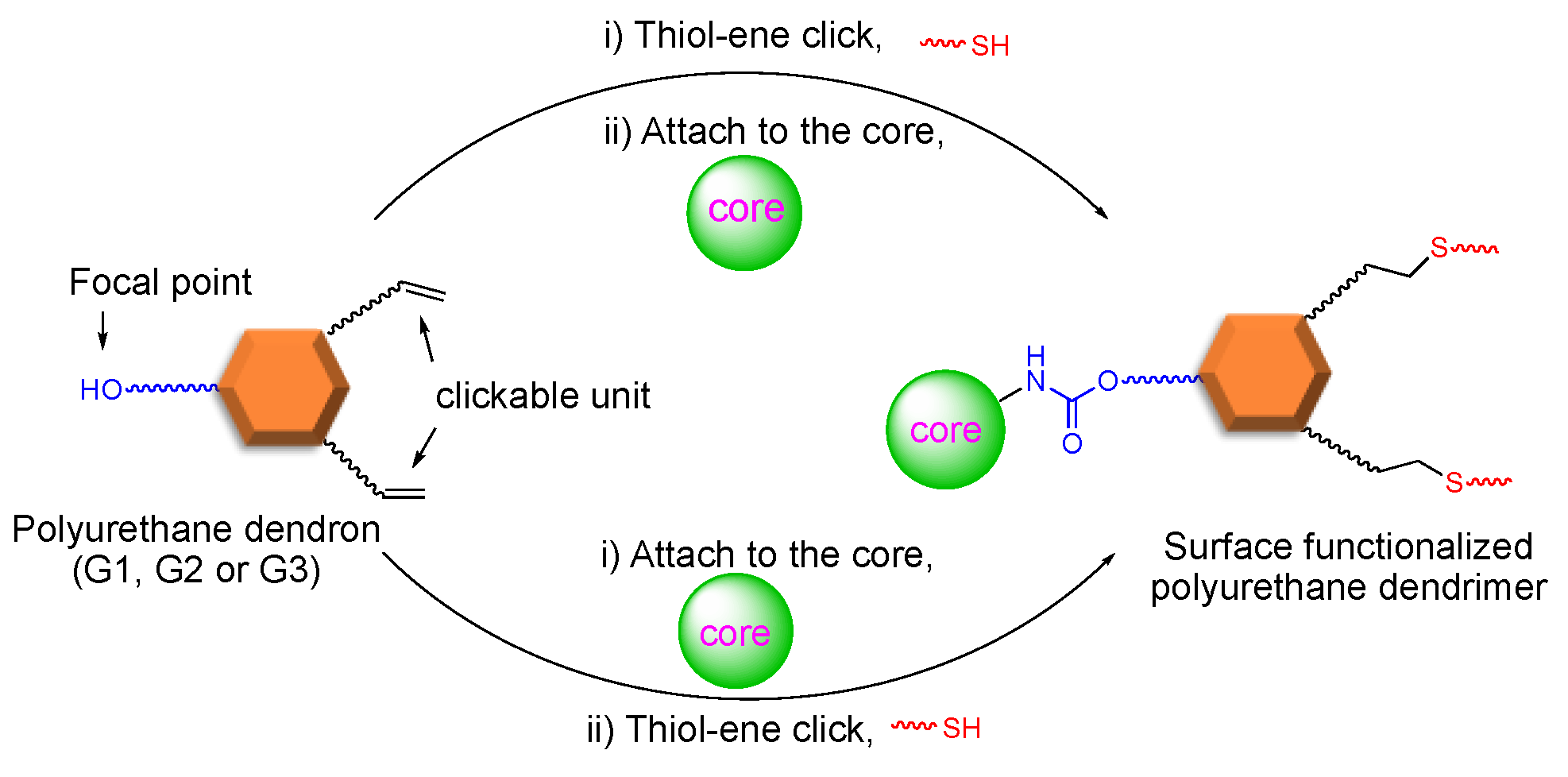
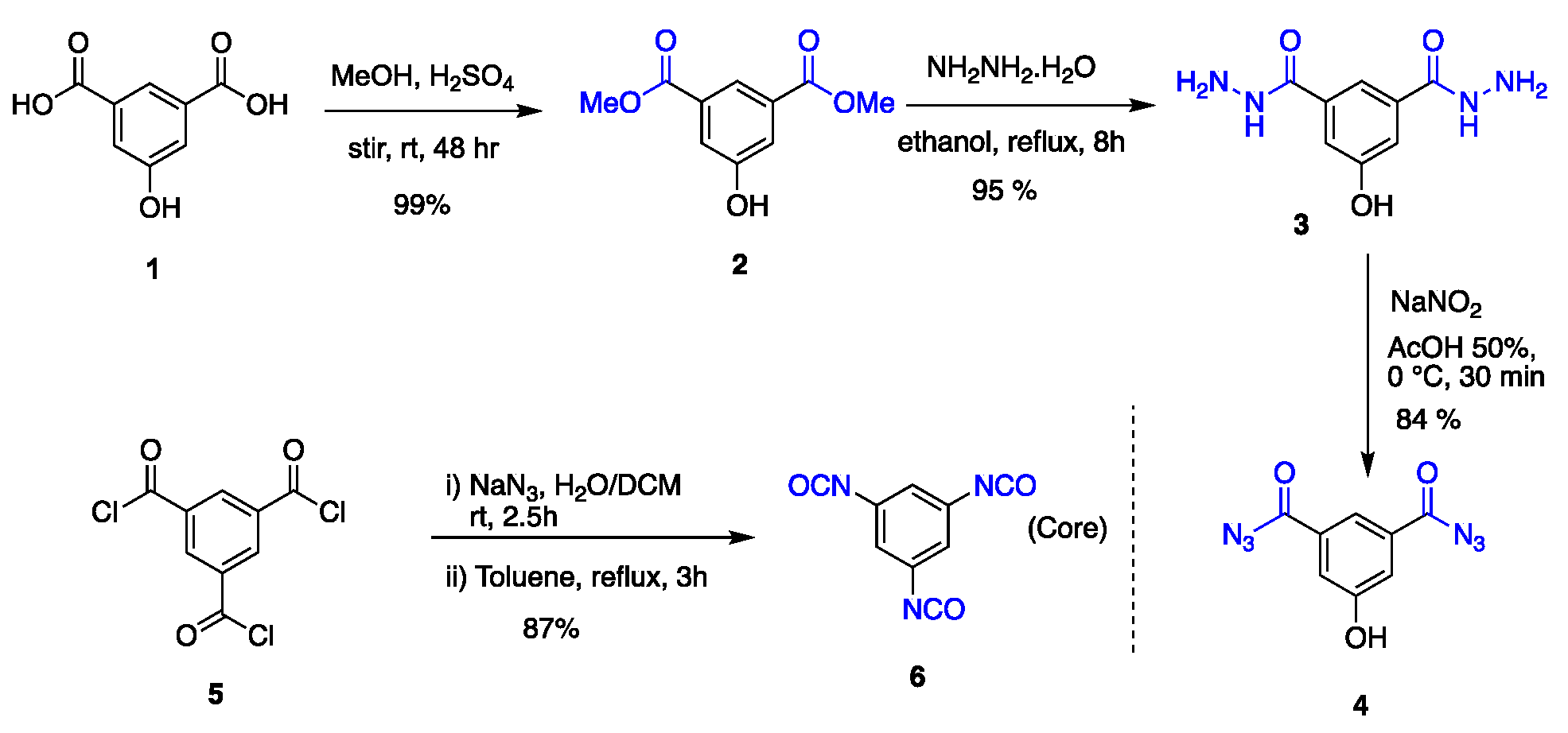
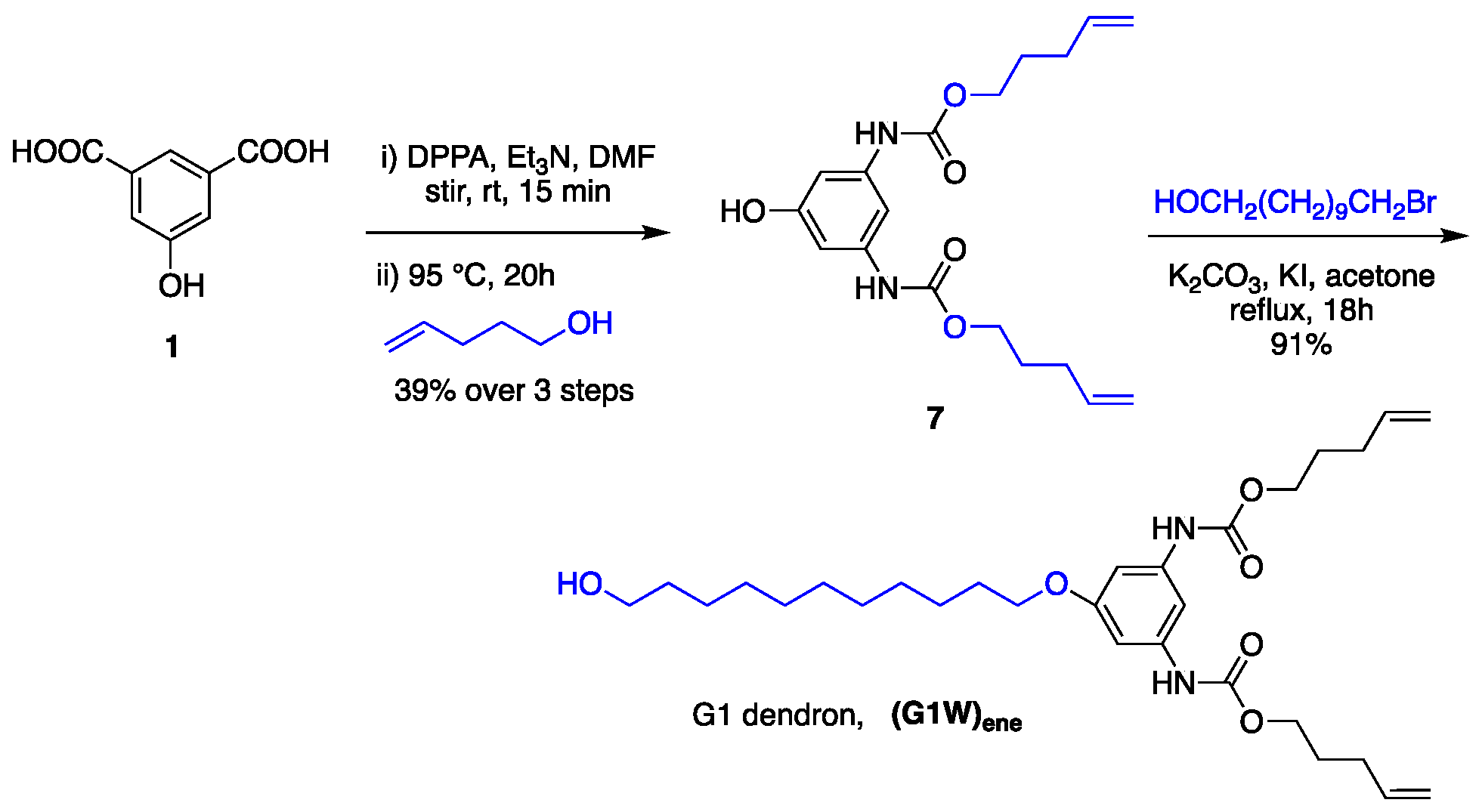
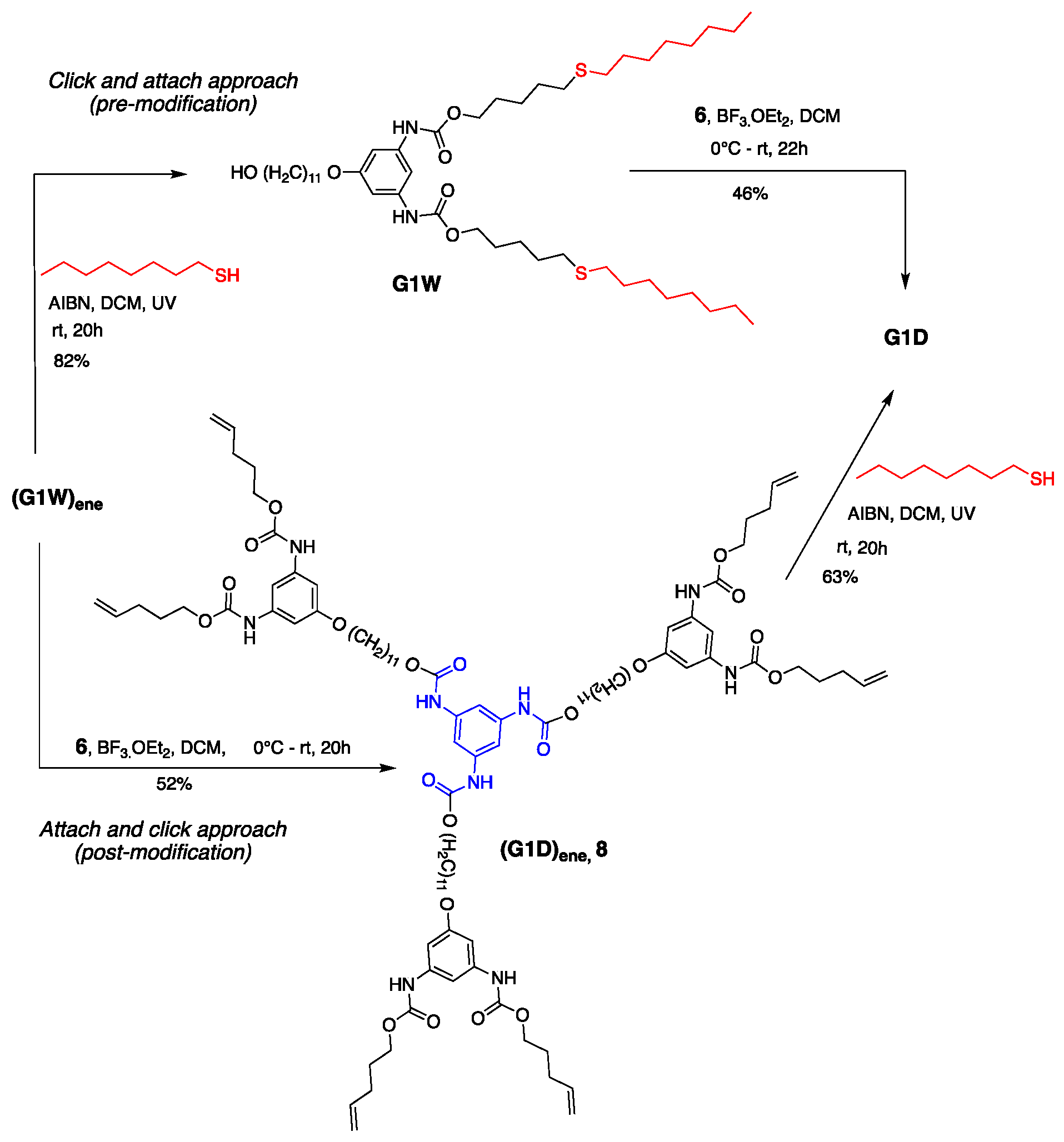


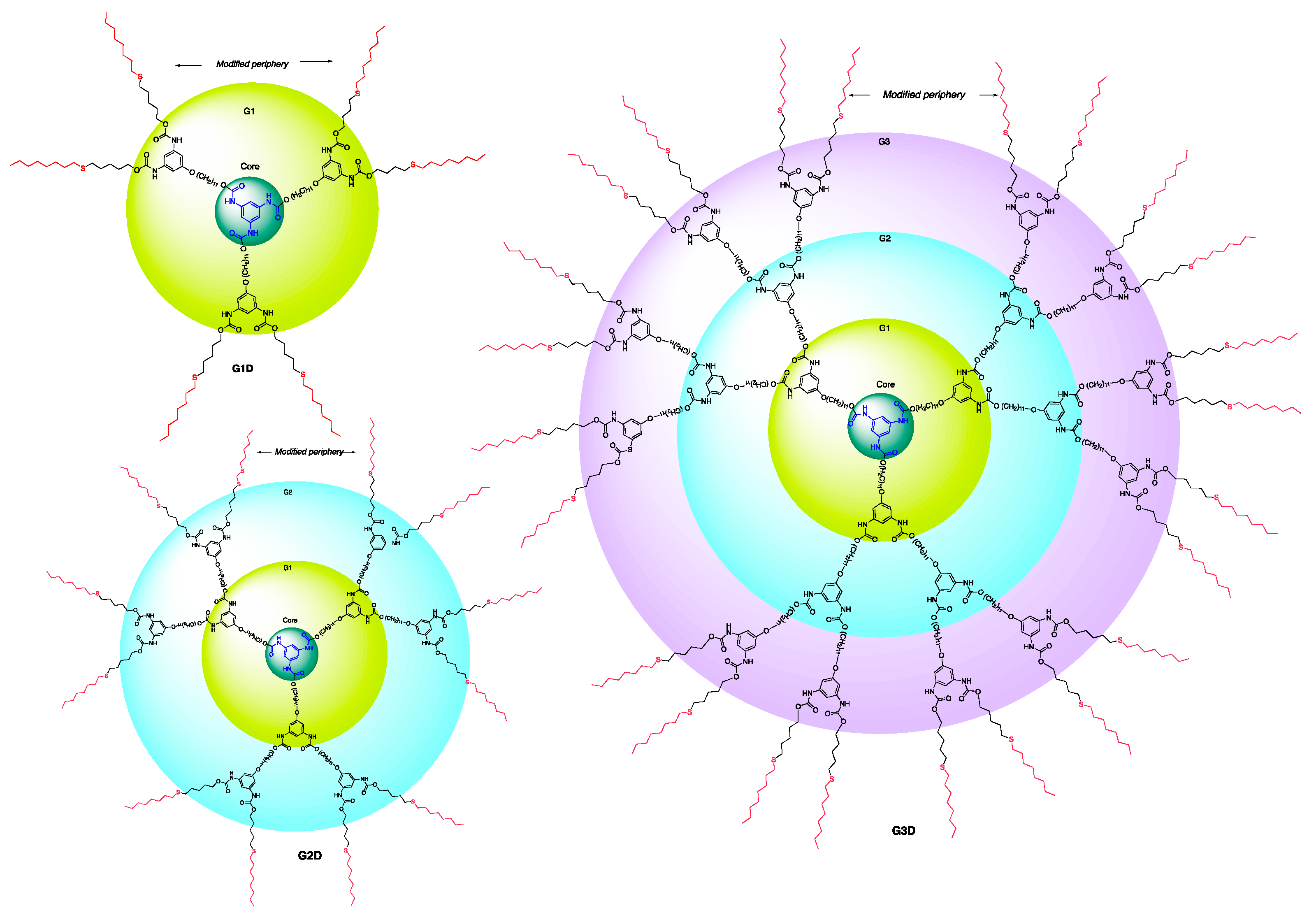


Publisher’s Note: MDPI stays neutral with regard to jurisdictional claims in published maps and institutional affiliations. |
© 2021 by the authors. Licensee MDPI, Basel, Switzerland. This article is an open access article distributed under the terms and conditions of the Creative Commons Attribution (CC BY) license (https://creativecommons.org/licenses/by/4.0/).
Share and Cite
Poudel, D.P.; Taylor, R.T. Thiol-Ene Click-Inspired Late-Stage Modification of Long-Chain Polyurethane Dendrimers. Reactions 2022, 3, 12-29. https://doi.org/10.3390/reactions3010002
Poudel DP, Taylor RT. Thiol-Ene Click-Inspired Late-Stage Modification of Long-Chain Polyurethane Dendrimers. Reactions. 2022; 3(1):12-29. https://doi.org/10.3390/reactions3010002
Chicago/Turabian StylePoudel, Dhruba P., and Richard T. Taylor. 2022. "Thiol-Ene Click-Inspired Late-Stage Modification of Long-Chain Polyurethane Dendrimers" Reactions 3, no. 1: 12-29. https://doi.org/10.3390/reactions3010002
APA StylePoudel, D. P., & Taylor, R. T. (2022). Thiol-Ene Click-Inspired Late-Stage Modification of Long-Chain Polyurethane Dendrimers. Reactions, 3(1), 12-29. https://doi.org/10.3390/reactions3010002





